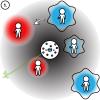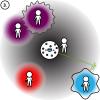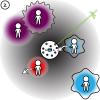Midterm Project - Sound Room
Sound Space - Derek Kan, Jenton Lee, Sandra Helsley
Description
We are conceptualizing a space that provides both audio and visual feedback depending on how people interact within its boundaries. Each participant holds a token, taken from some shared pool located in the centre of the space. The central position of the affords communal activities, which is beneficial for a party-like atmosphere (in our diagrams we have provided chips and dips for our participants).
Two parts make up the sound space: 1. a radar-like pulse, which sweeps through the space rhythmically, so that a sound is made as the arm sweeps over each participant, and 2. tokens, which are held by participants and determine their type of input.
Two types of tokens are available, turning the participants into either sound generators or sound modulators. Sound modulators affect the tones of sound generators, depending on their proximity to one another.
The area of effect of each participant is directly related to the person's position in the room. Participants towards the edges of the room have a greater effect. As each person moves to the centre of the room to put away the token or exchange for a new one, the area of effect decreases to 0.
Sound Generators
Description
- Users pick up a token that allows generation of a particular type of sound (based on the type of token that was picked up)
- The Sound Generator has a radius of influence. When a Sound Generator enters the radius of a Sound Modulator, then the Modulator begins to impact the sound coming out of the Generator.
Abilities
-
Proximity to center = ± volume
- As the user moves farther away from the center, the volume of his sound will change. (See spacediagram1.jpg.)
-
Rotational Position = ± Pitch
- as the Sound Generator rotates in place, the pitch of his sound will change.
Sound Modulators
Description
- Users pick up a token that allows modulation of the output of the sound generators.
- The Sound Modulator has a radius of influence. When a Sound Generator enters the radius of a Sound Modulator, then the Modulator begins to impact the sound coming out of the Generator. (See spacediagram0.jpg and spacediagram1.jpg.)
Abilities
- Proximity to Sound Generator = ± modulation effect
- Angle relative to the Sound Generator = ± 2nd modulation effect
Radar Sweeper
Description
- An invisible arm from the center will rotate around the playing area, in 360 degrees, based on the BPM. As the arm passes over the Sound Generators and Modulators, their function is activated once. The Generators and Modulators will be activated again when the invisible arm makes a full revolution.
- Login to post comments



